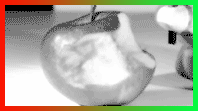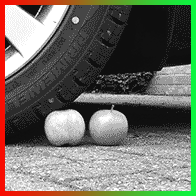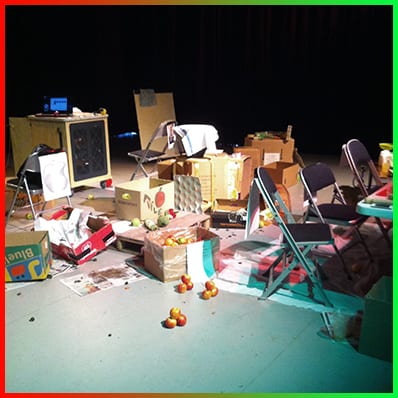Site specific drama challenges the performer to take the performance out of the confines of the ‘black box’ performance space to create new, unique and innovative theatre We, as a group, decided to take this one step further and challenge what we as performers and people think about the pre-written concepts of objects as well as the space itself. It is a widely discussed debate to argue the concept of nature verses nurture in human development – whether we behave as we are due to genetics or learned behaviour, and this can also be applied to space and objects in the world around us. As well as re-writing the already specified ‘script’ of an empty shop which was our assigned performance space, our piece will eventually be a part of the Gravity Fields Festival in Grantham, so the stimuli for our performance was to delve into the theme of science – however that may be interpreted. Being heavily influenced by both the concept of using a shop window as our performance area as well as Grantham’s great myth of the apple falling on Isaac Newton’s head, we decided to base our performance on the quite literal ‘101 things to do with an apple’. Right from the start, we knew that this idea would have the freedom and the capacity to explore our ideas and challenge ourselves with thinking outside of the box and pre-existing behaviours outlined for us as individuals within a society where everything has its own function. We wanted to share our experiences with an audience using a mix of continuous live performance, media and installation pieces as a showcase of all our work through the devising process.
As a newly formed production team within our group, we were quick to land on our initial idea, as it was one that we were all interested in and believed that we could each have a lot to offer both practically and theoretically into the final performance. We knew that we wanted to include media into our performance to add another dimension to the piece without being strictly restricted to the space of the shop, which would allow us to tackle visually stimulating tasks we would otherwise not be able to do live – such as long term apple rotting. Instead of taking a scientific subject, such as an exploration between the differences in speed of light and sound, which was our other original concept of the ‘Light and Sound Olympics’, we decided to instead apply science onto our apple idea. We believed that this way, we could create a piece that could accommodate many particular tastes, including families, and yet still be relevant for the Gravity Fields Festival. Not only did we believe that we could use our given site and scientific aim to our potential, but we wanted to make it interesting and fun to the wide range of the general public, who were our desired audience, as our shop was situated in the middle of the high street.
(Fig.1. The Newton’s Apple Cradle trial run)
As a starting position, we drafted an initial lift of 101 different things we could possibly do with apples. Not only did we include domestic uses for apples – such as cooking, cutting and eating, but we were most interested in listing a large number that would serve as a way to attract an audience through unique and innovative ideas such as making a Newton’s Cradle out of apples. Early on, we decided that we were not going to show all 101 (or more) tasks through live action and were going to be using pre filmed media and installation. As we were going to be performing in a shop, using the space to display our collections and creations seemed like the perfect idea. It was at this stage where we were toying with the idea to provide the audience with either a checklist to mark off the ways of using apples as they saw them or a blank list in which they were to write the ways that they saw as individuals. As our piece was very much in the early stages, we decided to save our decision to a later date rather than basing our piece around it. We wanted as blank of a canvas as possible to approach the piece with an open mind.
(Fig.2. The Apple Masterlist)
Through discussions in class, the nature verses nurture discussions and how we, as human beings, deal with the idea of pre-taught behaviours was definitely a huge inspiration for our performance. In his chapter ‘Walking in the City ‘ within his influential book ‘The Practice of Everyday Life’, De Certeau paints the picture of standing on top of the World Trade Centre in New York and using it as a vantage point in order to view the city and it’s commotion as people go about their everyday lives below. By taking one’s self out of the situation and not having to abide by the written ‘laws’ and pre-taught behaviour of being on street level with the ‘walkers’, it allows the viewer to then study behaviour at a god-like vantage point using the power of omniscience. In many ways, the city could have been seen as a site specific piece and people are to follow the script of the city, performing their everyday tasks, which sits alongside the theory that everything we do is a performance. Thinking on psychological terms, this supports that we, as humans, perform through learned behaviour (or nurture) and as we grow, we add to our life script through our experiences.
Taking this into account, we wanted to step back from the pre-written ideas and structures of the apple as an everyday object and treat it as though it (and we) were a blank canvas. Instead of viewing the fruit as something that we eat, we wanted to utilise everything it was capable of doing and being used for – such as a paintbrush, colouring and an aid to exercise training. We knew that our audience might find some of our uses and methods strange, but we hoped that this would get them to question their own nurture and realise that thinking along those lines meant that they were stuck in the confines of their learned behaviour and projecting that onto an object instead of opening their mind to new things.

(Fig.3 The Rotting Apple)
The use of multimedia does not change the site, but can greatly enhance the way in which the site is used by adding another dimension outside of the performance space and the performance time which would recontextualize the entire performance. Extending our performance with film was definitely something that we wanted to do to include those tasks which would have been impractical or dangerous to take place in the time and place of our site. By adding this further dimension, we knew we would be expanding the parameters for what ‘site’ meant, as well as giving our piece a surreal and modern twist which we hoped would contrast other displays shown at the Gravity Fields Festival. In terms of what we wanted to challenge our audience both psychologically and theoretically, it was our want to make ourselves memorable. If our audience members left our performance space entertained, reeling over their individual thoughts or both, we knew we would have succeeded in performance.
During our initial filming process, both as a group and me by myself as the multimedia side was mainly my input into the performance preparation, we tried to stick to our original 101 ideas but came across new ideas in the journey to our final performance. As we researched more around the topic, we learned of uses of apples we hadn’t thought of. These both included the use of popular culture such as YouTube and apples within games console games which emerged at a later date and added to the video as well as more epic uses that would serve well in a multimedia presentation. These included our Apple Chainsaw Massacre and Car verses Apple which we hoped would be an audience attraction.

(Fig.4 Car Vs Apple)
The structure of our piece was the last element we decided to focus on. For most of our devising process, we were going to fill our performance space with installation displays and scientific experiments involving apples, guide our audience through as the moderators and have scheduled performance breaks that we could advertise and attract audiences at different points. Doing this meant that we would be able to utilise the site of the shop with smaller storerooms for performance as well as the large outside space on the street and the shop window itself for the public to be an outside eye looking in – much like the omniscient eye or the ‘spectator’. These breaks into ‘flash mob’ performance would have been epic in theory and we experimented with a few. These included our comedy sketch of the story of Isaac Newton and a rehearsed and structured ‘Apple Circus’. Though these short performances worked in theory when performed for a class of our peers, we decided that it wasn’t right for the performance we wanted to convey – especially due to the fact our site was changed to the studios of the LPAC for our examinations instead and wouldn’t be moved to the shop site until the Gravity Fields Festival during the last few weeks of performance preparation. With this in mind, we then had to adapt our piece to be able to fit two different sites.
Changing our structure, we decided to perform continuously, with the audience able to move around the space freely and un-controlled by the usual boundaries of the everyday auditorium style of theatre. With our mechanical-like structure of the starting and stopping of silent tasks of varying length using the bell, our performance could be described as being very Brechtian. We took our performance back to the bare basics, much like throughout our development and theoretical/psychological process, and included no actors, no characters and no scripting. We were black canvasses that added to the elements of the performance, much like the apples themselves. With this in mind, we believed that we could challenge the audience deeper into that thoughtful state by creating a space where, as quoted by Brecht himself – ‘things are the way they are, things will not stay the way they are’. (The Book of Positive Quotations (2007) by John Cook, p. 390)
(Fig.5. The set after performance day in state of decay)
Coming to the day of the performance and our final rehearsals, we got to put all of our ideas into practice. After collecting apple related products, 300 apples, grocery boxes and items that we had crafted ourselves, we got the opportunity to construct our set for the first time. Much like what we had practiced with theories previously, we wanted to use the boxes and apples in ways different than what they were originally intended – as furniture and decoration. To combat our very structured performance style, it was important to us that our set looked like ‘organised chaos’. Everything we needed for performing was to be within the space in which the set was positioned and would all, in one way or another, be used in performance and even added to as we made and destroyed apple products through performance. This chaotic appearance was also filled with apple items on the list to find, meaning that the audience had to move around the space and examine our installation.

From start to finish, I believe that our final performance ran very smoothly. The use of the bell to signify the start and finish of a particular live element gave the piece a clockwork-like professional feel. With the use of the whiteboard to actively write whatever live element that whichever member of the group decided to right the bell and move the piece forward and the people who wish to perform live stand up went as smooth as we expected. Doing it this was, as opposed to having a written structure and timings made the piece spontaneous for us as well as the audience. This way, we were simply carrying out tasks in a naturalistic way as opposed to taking on the role of the performer.
As far as the audience were concerned, we received a steady amount throughout the day. Some filled out the tick sheets and others preferred to just view our piece on its own. It was interesting to watch the behaviour of the audience during particular acts. Some embraced the performance space and respected the boundaries between viewing space and the installation, walking around the space and actively searching out and trying to pick out as much as they could from the piece. Looking at the collected sheets at the end of the performance day after two non-stop sessions of performance, we found that quite a few people found a great number of the things on the checklist which must have meant that they stayed to view the performance for quite some time as the full length of the film lasted 40 minutes and must have spent time walking around the set and viewing live activities. This was very different from others who kept their distance, only viewing the live art instead of searching around the space and there were even two individuals who sat in the doorway, obviously overwhelmed by what they had to do with the strange, intimate space. On a few occasions, the audience decided to take full use of the mechanics of our performance and step forward to ring the bell to end a certain activity. Initially, the bell was just to be used to communicate through our silent atmosphere as the only sounds we wanted were from the tasks, but I believe that the small audience participation was very effective, though it was not expected. When we re-perform the piece in the Gravity Fields Festival, audience participation will definitely be more actively involved by making the bell assessable. As far as the set was concerned, our performance was very messy at times which caused the set to decrease in quality. Although the set itself was extremely effective and interesting from the feedback we have heard from the audience, it would be an idea to take some time in the middle of the performances to re-set the stage to provide some, but not too much set decay.

(Fig.6. An apple.. Is an apple.. Is an apple.)
Birch, A & Tompkins, J (10 Oct 2012). Performing Site-Specific Theatre: Politics, Place, Practice (Performance Interventions). Palgrave Macmillan
Cook, J (2007). The Book of Positive Quotations. 2nd ed. Fairview Press. p. 390.
De Certeau, Michel. The Practice of Everyday Life, trans. Steven Rendall, University of California Press, Berkeley 1984
Pearson, M (2010) Site-Specific Performance, Hampshire: Palgrave Macmillan.
Wilkie, F. (June 2004). Out Of Place. The Negotiation of Space in Site-Specific Performance.





